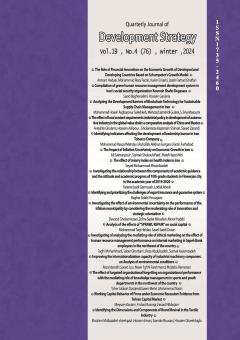The effect of local content requirements industrial policy in development of automotive industry in the global value chain: a comparative analysis of China and Mexico
Subject Areas :Fereshte Gholami 1 * , Hosein Aslipour 2 , Gholamreza Kazemian 3 , Saeed Zarandi 4
1 - IKCO, Strategy Expert
2 -
3 - Associate Prof., Faculty of management and Accounting, Allameh Tabataba'I University, Tehran,Iran
4 - Assistant professor, Allame Tabatabaei
Keywords: Keywords: Comparative policy analysis, Industrial policy, Local content requirements, Global value chain, Automobile industry.,
Abstract :
Fereshte Gholami Hossein Aslipour Gholamreza Kazemian Shirvan Saeed Zarandi Abstract With reference to comparative policy studies and the level of competitiveness throughout the global value chain (GVCs), the effect of related policies can be traced. This article aims at studying industrial policy of local content requirements (LCRs), which are among the most prevalent as well as primary policiese used in any development model. This has been done to study the effect of LCRs on upgrading the position of a country’s automotive industry concerning GVCs through a variable- oriented approach. China and Mexico have been picked out in accordance with sample selection approach in the systems encompassing a great deal of similarities as well as the most similar outcomes. Further to the historical review of the development process of the automotive industry, focusing on the LCRs policy, the effect of this policy on the three indicators FVASH, REII and DVAFXSH has been carried out by logistic regression. These indicators determine the level of competitiveness throughout GVCs. The logistic regression shows a significant logit relationship between the LCRs policy status and the DVAFXSH variable, but no significant relationship is observed for the other two variables. The trend review also shows that after the implementation and removal of LCRs, the FVASH and REII indices have not changed much, but the DVAFXSH has increased, especially in Mexico.It shows that the systematic implementation of LCRs can have significant effects in upgrading the position of countries in GVCs in the automotive sector, through DVAFXSH.
- خنيفر، حسين؛ مسلمي، ناهيد. (1397). اصول و مباني روش هاي پژوهش كيفي، رويكردي نو و كاربردي (جلد اول). تهران: نگاه دانش.
- ریگین، چ. (1397). روش تطبیقی فراسوی راهبردهای کمی و کیفی (جلد چهارم). (م. فاضلی، مترجم) تهران: آگه.
- ساعی، ع. (1392). روش پژوهش تطبیقی با رویکرد تحلیل کمی، تاریخی و فازی. تهران: آگه.
- فتوحي اردكاني، ا. (1380). كتاب آموزشي SPSS 10. تهران: انتشارات چرتكه.
- معدندار آرانی، عباس؛ کاکیا، لیدا. (1398). روش تحقیق در علوم انسانی با تاکید بر مطالعات علوم تربیتی و روانشناسی. تهران: سازمان مطالعه و تدوین کتب علوم انسانی دانشگاهها (سمت).
- نجارزاده، ر.؛ عاقلي، ل.؛ درگاهي، ح.؛ و بياباني خامنه، ك. (1399). اندازه گيري شاخص هاي وضعيت اقتصاد ايران در زنجيره هاي جهاني ارزش و مقايسه با كشورهاي منتخب. نشريه علمي (فصلنامه) پژوهش ها و سياست هاي اقتصادي، 94، 129- 101.
- COVARRUBIAS, A. V. (2020). THE BOOM OF THE MEXICAN AUTOMOTIVE INDUSTRY: FROM NAFTA TO USMCA. IN A. V. COVARRUBIAS, & S. M. RAMÍREZ PEREZ, NEW FRONTIERS OF THE AUTOMOBILE INDUSTRY EXPLORING GEOGRAPHIES, TECHNOLOGY, AND INSTITUTIONAL CHALLENGES (PP. 323-348). PALGRAVE MACMILLAN.
- Engeli, Isabelle; Allison, Christine Rothmayr. (2014). In I. Engeli, & C. R. Allison, Comparative Policy Studies: conceptual and Methodological Challenges (pp. 1-14).
- Ferdous Azam, S. M. (2020, Jan). Investment and Financing Analysis: An Investigation of the Automotive Industry of China. Systematic Reviews in Pharmacy, 11(1), 913-919.
- Geva-May, Iris; Haffman, David C.; Muhleisen, Joselyn. (2018). Twenty Years of Comparative Policy Analysis: A Survey of the Field and a Discussion of Topics and Methods. Journal of Comparative Policy Analysis: Research and Practice, 20(1), 18-35. doi:10.1080/13876988.2017.1405618
- Howlett, M., & Cashore, B. (2014). Conceptualizing Public Policy. In I. Engeli, & C. R. Allison, Comparative Policy Studies: conceptual and Methodological Challenges (pp. 17-34).
- Hyun, Y. (2020). Catch-up to Lead in Korea’s Automobile Industry. In A. V. Covarrubias, & S. M. Ramírez Perez, New Frontiers of the Automobile Industry: Exploring Geographies, Technology, and Institutional Challenges (pp. 229-254). Palgrave Macmillan.
- Lee, Keun; Mao, Zhuqing;. (2020). GVC (gloval value chains), industrial policy, and industrial upgrading: Automotive sectors in Malaysia, Thailand, and China in comparision with Korea. European Journal of Development Research. doi:10.1057/s41287-020-00354-0
- Natsuda, K., & Thoburn, J. (2021). Automotive Industrialisation: Industrial Policy and Development in Southeast Asia. Routledge-GRIPS Development Forum Studies.
- Natsuda, K., Thoburn, J., Blazek, J., & Otsuka, K. (2020). Industrial policy and automotive development: a comparative study of Thailand and Czechia. Eurasian Geography and Economics, p. Article in press. doi:10.1080/15387216.2020.1836983
- Radin, Beryl A; Weimer, David L;. (2018). Compared to what? The multiple meanings of comparative policy analysis. Journal of Comparative Policy Analysis: Research and Practice, 20(1), 56-71.
- Schrank, A. (2017). The Political Economy of Performance Standards: Automotive Industrial Policy in Comparative Historical Perspective. Journal of Development Studies, 53(12), pp. 2029-2049. doi:10.1080/00220388.2016.1228879
- THOBURN, S. A. J., & Natsuda, K. (2016). Comparative policies for automotive development in Southeast Asia. In A. Hansen , & K. B. Nielsen, Cars, Automobility and Development in Asia: Wheels of Change (pp. 27-46). Routledge.
- Wenten, F. (2020). The Automotive Industry in China: Past and Future. In A. Covarrubias V., & S. M. Ramírez Perez (Eds.), New Frontiers of the Automobile Industry Exploring Geographies, Technology, and Institutional Challenges (pp. 279-300). Palgrave Macmillan.

